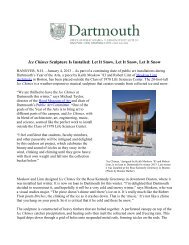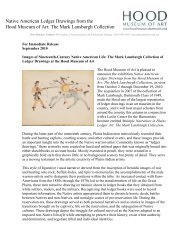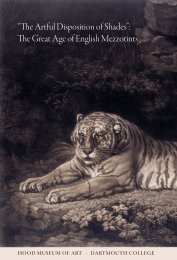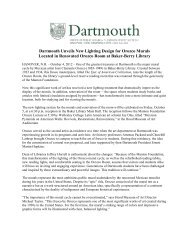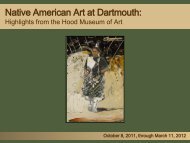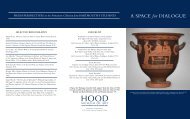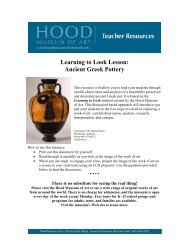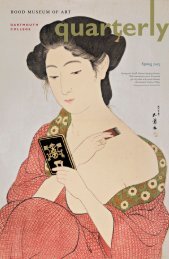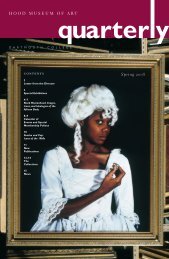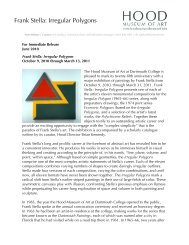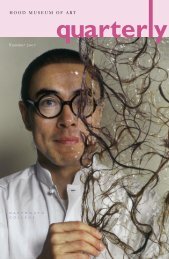Fall 2012 - Hood Museum of Art - Dartmouth College
Fall 2012 - Hood Museum of Art - Dartmouth College
Fall 2012 - Hood Museum of Art - Dartmouth College
You also want an ePaper? Increase the reach of your titles
YUMPU automatically turns print PDFs into web optimized ePapers that Google loves.
Special<br />
exhibitions<br />
Crossing Cultures<br />
The Owen and Wagner Collection <strong>of</strong><br />
Contemporary Aboriginal Australian <strong>Art</strong><br />
at the <strong>Hood</strong> <strong>Museum</strong> <strong>of</strong> <strong>Art</strong><br />
September 15, <strong>2012</strong>–March 10, 2013<br />
The pr<strong>of</strong>ound knowledge possessed by Indigenous people from<br />
Australia is powerfully communicated through the visualization<br />
<strong>of</strong> ancestral narratives that describe not only how the land was<br />
created but also how to ensure its continued vitality. This exhibition<br />
highlights the extraordinary Owen and Wagner collection at<br />
the <strong>Hood</strong> <strong>Museum</strong> <strong>of</strong> <strong>Art</strong>, <strong>Dartmouth</strong> <strong>College</strong>, through its display<br />
<strong>of</strong> more than one hundred works <strong>of</strong> contemporary Indigenous<br />
art from Australia. It represents the many art-making practices<br />
<strong>of</strong> Aboriginal peoples across the Australian continent, including<br />
acrylic paintings on linen and canvas, earthen ochre paintings<br />
on bark, board, and canvas, sculpture in a variety <strong>of</strong> media, and<br />
photography. While the exhibition features many influential artists<br />
who have contributed to the development <strong>of</strong> an Indigenous<br />
art canon since the 1970s, the focus is squarely on subsequent<br />
generations <strong>of</strong> artists, who are breathing new life into ancient stories<br />
and broadening the possibilities <strong>of</strong> Indigenous art. Resonant<br />
with cultural memory, these objects reference and reinvigorate<br />
customary iconographies, speak to the history and legacy <strong>of</strong> colonization,<br />
and affirm Robert Hughes’s statement that Aboriginal art<br />
is “the last great art movement <strong>of</strong> the twentieth century.”<br />
This exhibition was organized by the <strong>Hood</strong> <strong>Museum</strong> <strong>of</strong> <strong>Art</strong> and generously<br />
supported by Kate and Yaz Krehbiel, Class <strong>of</strong> 1991, Thayer 1992, Hugh J.<br />
Freund, Class <strong>of</strong> 1967, the Leon C. 1927, Charles L. 1955, and Andrew J. 1984<br />
Greenebaum Fund, and the Philip Fowler 1927 Memorial Fund.<br />
(top) Michael Riley, Wiradjuri/Kamilaroi, 1960–2004, Untitled (from the<br />
series cloud), 2004, inkjet print on Ilford Galerie paper, ed. 2/5. Promised<br />
gift <strong>of</strong> Will Owen and Harvey Wagner; EL.2011.60.59. © <strong>2012</strong> <strong>Art</strong>ists<br />
Rights Society (ARS), New York / VISCOPY, Australia<br />
(middle) Pedro Wonaeamirri, Tiwi, born 1974, Untitled, 1999, ochres on<br />
canvas. Gift <strong>of</strong> Will Owen and Harvey Wagner; 2011.43.107. © <strong>2012</strong><br />
<strong>Art</strong>ists Rights Society (ARS), New York / VISCOPY, Australia<br />
(bottom) Craig Koomeeta, Wik-Alkan, born 1977, Min Kéna (Freshwater<br />
Crocodile), 2002, ochres and acrylic on milkwood. Promised gift <strong>of</strong> Will<br />
Owen and Harvey Wagner; EL.2011.60.47. Courtesy <strong>of</strong> the artist and<br />
the Wik and Kugu <strong>Art</strong>s and Craft <strong>Art</strong> Centre.<br />
Stacey Steers: Night Hunter House<br />
August 25–December 16<br />
Gutman Gallery<br />
Night Hunter House, a recent <strong>Hood</strong> acquisition now on view for the first time, is by<br />
Denver-based multimedia artist Stacey Steers. The dollhouse is conceived around and<br />
incorporates segments from Steers’s sixteen-minute handmade film Night Hunter (2011)<br />
on ten small HDTV screens embedded in the house. Visitors who peek into the rooms<br />
through the house’s windows are exposed to a surreal world filled with snakes, giant<br />
moths, pulsating eggs, and strange happenings. Silent film star Lillian Gish (1893–1993)<br />
has been transported from several <strong>of</strong> her best-known films to become the dweller <strong>of</strong><br />
the house and the film’s protagonist through Steers’s expert collage artistry. Steers’s<br />
film Night Hunter (2011), upon which this work is based, will screen continuously in the<br />
<strong>Hood</strong> <strong>Museum</strong> <strong>of</strong> <strong>Art</strong> Auditorium on selected days each week. The schedule is posted<br />
on the <strong>Hood</strong>’s website and in the galleries.<br />
Stacey Steers, Night Hunter House (detail), 2011, mixed media, music and sound by Larry Polansky.<br />
Purchased through the Julia L. Whittier Fund and the Claire and Richard P. Morse 1953 Fund; <strong>2012</strong>.6.<br />
HOOD QUARTERLY 3



